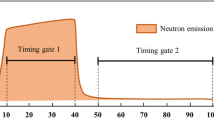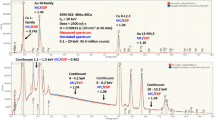Abstract
A digital twin system for a gamma-ray spectrometer was developed using the Geant4 Monte Carlo simulation toolkit and a dedicated novel methodology. The model system was verified to accurately represent the intrinsic characteristics of gamma-ray detection systems: not only Gaussian energy broadening caused by energy resolution, but also count loss and coincidence summing caused by the dead time and charge collection time, respectively, of the detector system. In order to represent the time-related phenomena, the results of the Monte Carlo simulation were printed out in list-mode data rather than (as in existing previous studies) as a simple energy spectrum. The list-mode data were then post-processed considering the characteristics of the gamma-ray detection systems. The model system was verified by comparison with real-world experimental data using radiation sources (137Cs and 60Co) and a high-purity germanium detector, the results of which showed that the spectra generated by the model well matched the experimental spectra throughout the entire energy range (0–3 MeV), with correlations of 94.3 and 94.6% for 137Cs and 60Co, respectively.













Similar content being viewed by others
References
R. Chalapathy and S. Chawla, “Deep learning for anomaly detection: A survey”, arXiv:1901.03407v2 (2019)
G. Pang et al., “Deep learning for anomaly detection : A review”, arXiv:2007.02500v3 (2020)
Ghawaly, James M. Jr, “A Datacentric Algorithm for Gamma-ray radiation anomaly detection in unknown Background Environments.” PhD diss., University of Tennessee (2020)
Sheng Qi, “Radionuclide identification method for NaI low-count gamma-ray spectra using artificial neural network. Nuclear Eng Tech 54(1), 269–274 (2022)
T. Kin, J. Goto and M. Oshima, “Machine Learning Approach for Gamma-ray Spectra Identification for Radioactivity Analysis,” 2019 IEEE Nuclear Science Symposium and Medical Imaging Conference (NSS/MIC) https://doi.org/10.1109/NSS/MIC42101.2019.9059618 (2019)
G. Daniel, F. Ceraudo, O. Limousin, D. Maier, A. Meuris, Automatic and Real-time identification of radionuclides in gamma-ray spectra: A new method based on convolutional neural network trained with synthetic data set. IEEE Transactions on Nuclear Science 67(4), 644–653 (2020)
Sahiner, Huseyin, “Gamma spectroscopy by artificial neural network coupled with MCNP" Doctoral Dissertations. 2598 (2017).
Dajian Liang, Pin Gong, Xiaobin Tang, Peng Wang, Le. Gao, Zeyu Wang, Rui Zhang, Rapid nuclide identification algorithm based on convolutional neural network. Annals Nuclear Energy 133, 483–490 (2019)
Whalen, D J, Cardon, D A, Uhle, J L, and Hendricks, J.S. MCNP: Neutron benchmark problems. United States https://doi.org/10.2172/10103487 (1991)
A. Turner et al., J. Phys.: Conf. Ser. 1643, 012211 (2020)
S. Hurtado, R. Garcia-Tenorio, M. Garcia-Leon, Coincidence summing corrections in gamma-ray spectrometry using GEANT4 Code. IEEE Transactions on Nuclear Science 56(3), 1531–1536 (2009)
Shoaib Usman, Amol Patil, Radiation detector deadtime and pile up: a review of the status of science. Nuclear Eng Tech 50(7), 1006–1016 (2018)
S. Agostinelli et al., Geant4 - a simulation toolkit. Nuclear Instruments Methods Phy Res Sect A 506(3), 250–303 (2003)
T. Goorley et al., Initial MCNP6 Release Overview. Nuclear Technology 180(3), 298–315 (2012)
J.S. Bendat, A. G. Piersol, Random Data, Wiley-Interscience (1986)
X-5 Monte Carlo Team, “MCNP – A General N-Particle Transport Code, Version 5 –Volume I: Overview and Theory,” LA-UR-03–1987, Los Alamos National Laboratory (April, 2003)
Acknowledgements
The authors would like to thank the Korea Atomic Energy Research Institute (KAERI) for the financial support of these studies under grants NRF-2017M2A2A6A05018528 and NRF-2018M2A2B3A06071695 from the National Research Foundation of Korea (NRF) and No. 2020-Tech-14 from the KOREA HYDRO & NUCLEAR POWER CO., LTD (KHNP). The authors would also like to thank all of those who contributed to the acquisition of research material.
Author information
Authors and Affiliations
Corresponding author
Additional information
Publisher's Note
Springer Nature remains neutral with regard to jurisdictional claims in published maps and institutional affiliations.
Rights and permissions
Springer Nature or its licensor (e.g. a society or other partner) holds exclusive rights to this article under a publishing agreement with the author(s) or other rightsholder(s); author self-archiving of the accepted manuscript version of this article is solely governed by the terms of such publishing agreement and applicable law.
About this article
Cite this article
Kwon, J., Kim, J., Kim, H. et al. Development of gamma-spectrum data generation method by Monte Carlo simulation. J. Korean Phys. Soc. 82, 658–670 (2023). https://doi.org/10.1007/s40042-023-00760-7
Received:
Revised:
Accepted:
Published:
Issue Date:
DOI: https://doi.org/10.1007/s40042-023-00760-7




